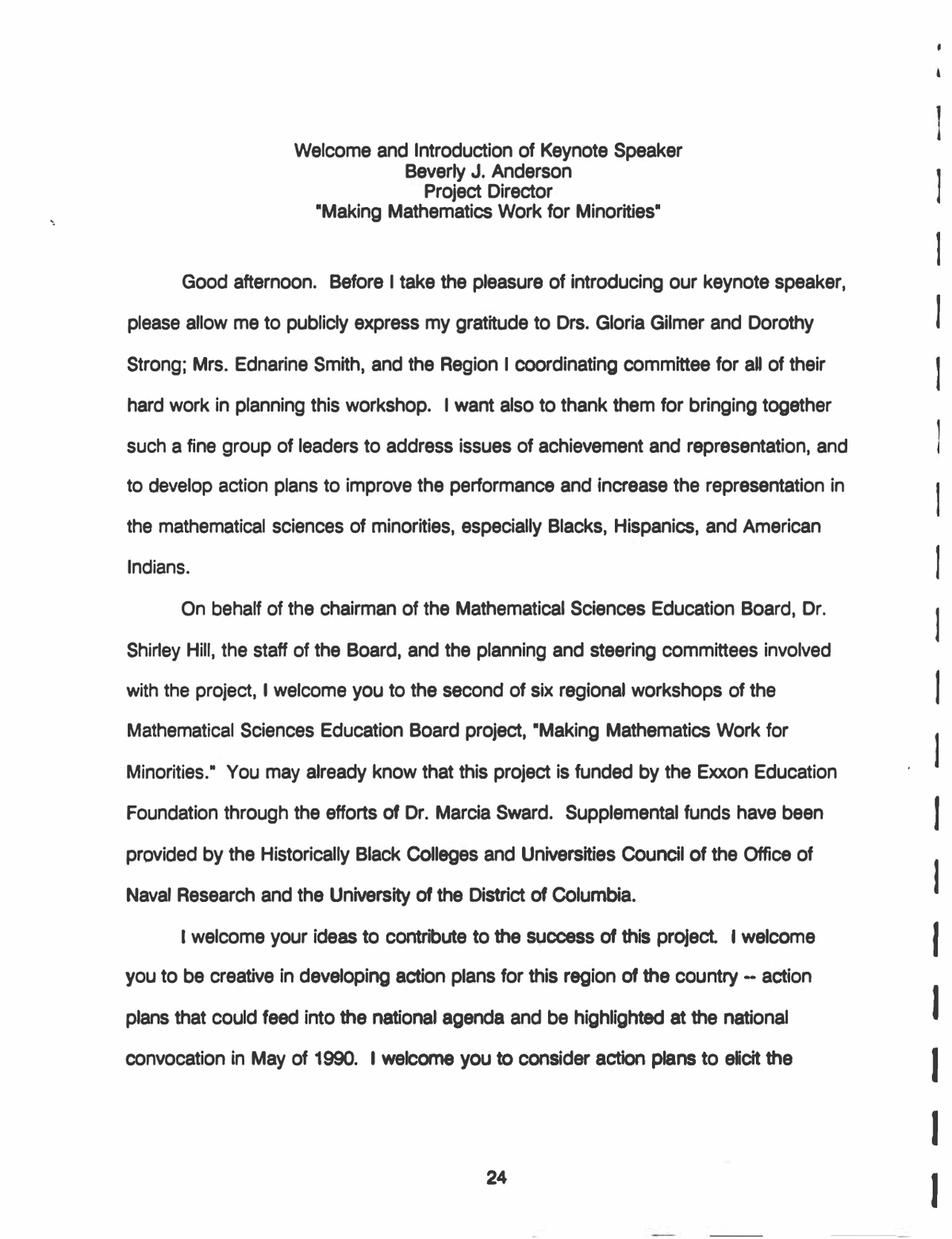How To Introduce A Keynote Speaker
To introduce a keynote speaker, start by providing the speaker’s name, their relevant credentials or expertise, and briefly highlight their main message or theme of their presentation. Then, mention the context of the event and why the speaker is a suitable choice for the audience.
Providing a brief anecdote or a notable achievement of the speaker can help create interest and captivate the audience’s attention. This introduction should be concise, engaging, and set the stage for an impactful keynote presentation. Whether it’s a conference, seminar, or corporate event, a well-crafted introduction can create anticipation and set the right tone for the keynote speaker’s address.

Credit: ecommons.udayton.edu
Preparing For The Introduction
Preparing for the introduction of a keynote speaker is crucial for a successful event. Learn how to captivate your audience, set the tone, and create anticipation for the speaker’s presentation.
Gathering Relevant Information
Before introducing a keynote speaker, it’s crucial to gather relevant information about their background and expertise. This will help you tailor your introduction to highlight their accomplishments and set the right tone for the event.
To gather the necessary information, consider:
- Researching the speaker’s professional experience
- Reviewing their previous speaking engagements or presentations
- Exploring their published works or notable achievements
- Contacting the speaker or their representative for any additional details
Crafting A Powerful Opening Line
Your opening line sets the stage for the introduction and grabs the audience’s attention. It should be concise, impactful, and relevant to the speaker and the event. Consider using:
- A thought-provoking question: “Have you ever wondered what it takes to achieve great success?”
- An inspiring quote: “Nelson Mandela once said, ‘It always seems impossible until it’s done.'”
- A captivating statistic: “Did you know that our keynote speaker has helped over 100 companies improve their bottom line?”
- A compelling anecdote: “Picture this: a young entrepreneur with a revolutionary idea that changed an entire industry.”
Remember, a powerful opening line should create anticipation for the keynote speaker’s presentation and capture the audience’s interest from the start.

Credit: ecommons.udayton.edu
Structuring The Introduction
Introducing a keynote speaker is a crucial part of setting the tone for a successful event. A well-structured introduction not only provides the necessary background information about the speaker but also engages the audience and creates anticipation for what is to come. In this section, we will explore the key elements of structuring a captivating introduction for a keynote speaker. By following these guidelines, you can ensure that your introduction sets the stage for a memorable and impactful presentation.
Providing Background Information
Before diving into the speaker’s accomplishments, it is important to provide some background information to establish their credibility. Briefly explain why the speaker is an expert on the topic they will be presenting, highlighting their relevant experience, education, or previous successes. This helps the audience understand why they should pay attention and lends authority to the speaker’s message. Remember to keep this section concise and focused, highlighting only the most important details.
Highlighting The Speaker’s Accomplishments
After providing the necessary background information, it’s time to showcase the speaker’s accomplishments. Share specific achievements, honors, awards, or accolades that highlight their expertise and reinforce their credibility. Whether it’s groundbreaking research, industry recognition, or notable contributions to their field, make sure to emphasize the speaker’s unique contributions and what sets them apart from others. This will not only elevate their reputation in the eyes of the audience but also build anticipation for what they have to share.
Creating An Engaging Connection
Building a connection between the speaker and the audience is crucial for capturing their attention and fostering a sense of relatability. To do this, find common ground between the audience and the speaker. Highlight any shared experiences, values, or challenges that make the speaker’s message relevant and relatable to the audience. By establishing a connection, you will help the audience feel invested in the speaker and eager to hear what they have to say.
Teasing The Audience With What’s To Come
Lastly, tease the audience with a sneak peek of what is to come in the speaker’s presentation. Offer a tantalizing glimpse of the key ideas, insights, or solutions that the speaker will be sharing. Paint a picture of the transformation or impact that the audience can expect from attending the keynote. This not only sparks curiosity and excitement but also ensures that the audience is engaged and eager to listen throughout the entire presentation.
Delivering The Introduction
Delivering a captivating introduction for a keynote speaker is crucial in setting the right tone and engaging the audience right from the start. Just as a first impression matters, the introduction plays a significant role in creating anticipation and building credibility for the keynote speaker. In this section, we will delve into the key aspects that can help you deliver the introduction with confidence and clarity.
Practicing The Introduction
Practicing the introduction beforehand is essential to ensure smooth delivery and avoid stumbling over words. By rehearsing, you enhance your familiarity with the content and gain the necessary confidence to engage the audience. Here are a few strategies to consider:
- Write the introduction in bullet points or short phrases.
- Break it down into smaller sections to make the memorization process easier.
- Practice reading the introduction aloud multiple times to refine your delivery.
- Record yourself to identify areas that need improvement.
Setting The Right Tone And Energy
The tone and energy of your introduction have a significant impact on the overall atmosphere of the event. To set the right tone, consider the nature of the event and the audience’s expectations. Here are a few tips to ensure you create the desired atmosphere:
- Research the keynote speaker thoroughly to understand their background, achievements, and expertise.
- Use powerful and enthusiastic language to capture the audience’s attention.
- Incorporate relevant anecdotes or stories to establish a personal connection.
- Pay attention to your body language, using confident and energetic gestures.
Maintaining Confidence And Clarity
Maintaining confidence and clarity throughout your introduction is essential to establish your credibility and engage the audience effectively. Follow these tips to ensure your delivery is polished and impactful:
| Tips for Maintaining Confidence and Clarity |
|---|
| Make eye contact with the audience to establish a connection. |
| Speak clearly and enunciate your words to enhance understanding. |
| Use pauses effectively to create emphasis and allow the audience to absorb your words. |
| Be mindful of your pace, avoiding rushing or speaking too slowly. |
By practicing, setting the right tone, and maintaining confidence and clarity, you can deliver an introduction that captivates the audience’s attention and paves the way for a successful keynote speech.

Credit: nap.nationalacademies.org
Tips For A Memorable Introduction
When it comes to introducing a keynote speaker, the right approach can make all the difference. A memorable introduction sets the stage for a successful presentation while showcasing your own skills as the introducer. Keep these key tips in mind to deliver a powerful opening that leaves a lasting impression.
Keep It Concise
In a world filled with distractions, brevity is key. Keep your introduction concise, direct, and to the point. Avoid rambling or going off on tangents that could detract from the main event. Get to the heart of the matter in a succinct manner, prioritizing the key highlights that will capture the audience’s attention.
Inject Personality And Enthusiasm
Avoid a robotic delivery and let your personality shine through. Inject enthusiasm and genuine excitement when introducing the keynote speaker. Engage the audience with your tone of voice, body language, and facial expressions. Your energy will be contagious, creating a positive atmosphere and setting the tone for an engaging presentation.
Avoid Overshadowing The Speaker
While it’s important to showcase your skills, remember that the spotlight should ultimately be on the keynote speaker. Avoid overshadowing them by keeping the focus on their achievements, areas of expertise, and the value they bring. Highlight their credentials and unique perspective, but always maintain a respectful balance in your introduction.
Set The Stage For Success
Your introduction should serve as a launchpad for the speaker’s success. Create a seamless transition from the audience’s attention to the speaker’s expertise. Highlight the relevance of the topic and convey the speaker’s understanding of the audience’s needs. By setting the stage for success, you’ll captivate the audience and build anticipation for what’s to come.
Frequently Asked Questions On How To Introduce A Keynote Speaker
How Do You Introduce A Keynote Speaker?
To introduce a keynote speaker, mention their name, highlight their achievements, and create excitement with a captivating anecdote.
What Are The Best Ways To Grab The Audience’s Attention When Introducing A Keynote Speaker?
Engage the audience by stating the speaker’s relevance to their lives, sharing a surprising fact, or starting with a thought-provoking question.
How Long Should An Introduction For A Keynote Speaker Be?
A good introduction for a keynote speaker should be concise, lasting around 2-3 minutes, keeping the focus on the speaker and their expertise.
Conclusion
Introducing a keynote speaker requires careful planning and execution to set the tone for a successful event. By following these strategies, such as researching the speaker, customizing the introduction, and practicing delivery, you can effectively engage the audience and enhance the speaker’s credibility.
Remember, your introduction plays a crucial role in creating a positive first impression and setting the stage for a memorable experience. So, take the time to prepare, and you’ll be sure to impress both the speaker and the audience alike.





